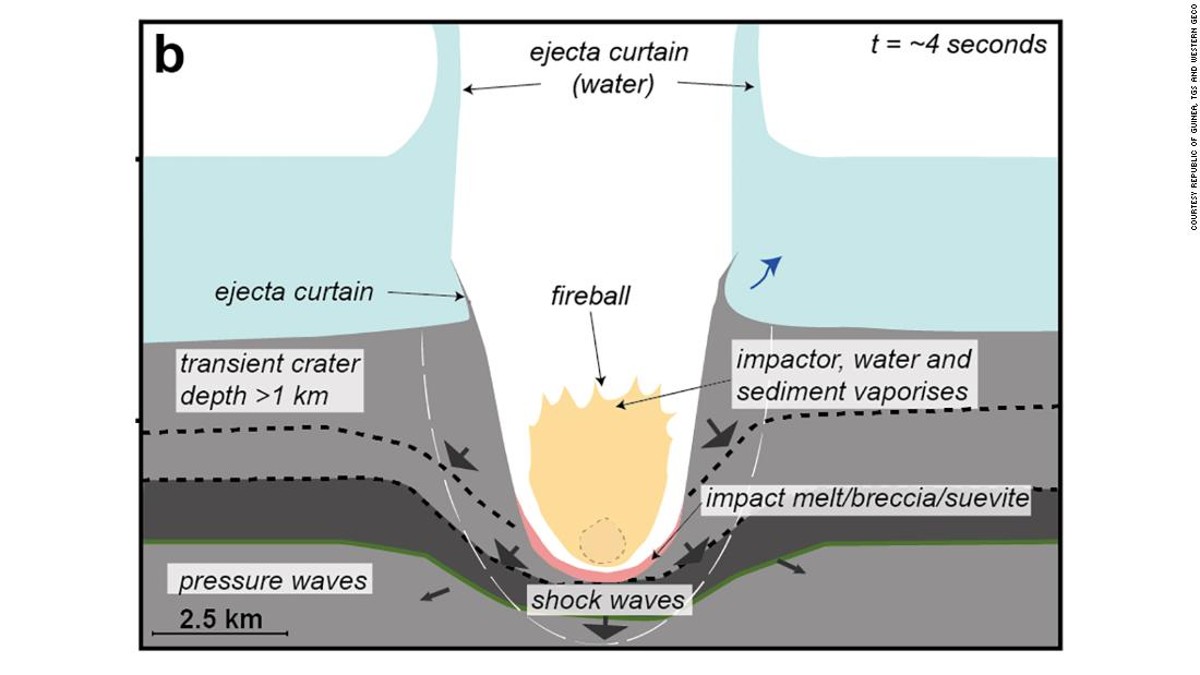(CNN) – 66 million years ago an asteroid crashed into the Earth’s surface, creating a huge crater under the ocean that wreaked havoc on Earth.
No, it wasn’t the asteroid that wiped out the dinosaurs, but a previously unknown crater that formed around the same time 400 kilometers (248 miles) off the coast of West Africa. Further study of Nadir Crater, as it will be called, could revolutionize what we know about that cataclysmic moment in natural history.
Uisteen Nicholson, an assistant professor at Heriot-Watt University in Edinburgh, found the crater by chance: he was analyzing seismic survey data for another project on the tectonic divide between South America and Africa. Seabed sedimentation.
“While interpreting the data, I saw this unusual crater-like feature unlike anything I’d seen before,” he said.
“It had all the characteristics of an impact crater.”
To confirm that the crater was caused by an asteroid impact, it would be necessary to drill it and test the minerals in the crater floor, he said. But it has all the features scientists expect: the width and depth of the crater, the height of the rims and the height of the central uplift, a ridge in the center formed by rocks and sediment pushed up by pressure. of vulnerability.
magazine Science Advances published the paper On Wednesday.
“The discovery of terrestrial impact craters is always important because they are so rare in the geologic record. There are less than 200 confirmed impact structures on Earth and a few more potential candidates that are undoubtedly unconfirmed,” Mark said. Boslow is a research professor of Earth and planetary sciences at the University of New Mexico. Boslough was not involved in the research, but agreed that the crater could be caused by an asteroid.
The most important aspect of the discovery is that it is an example of an underwater impact crater, Boslow said, of which there are only a few known examples.
“The opportunity to study a submarine impact crater of this scale will help us understand the process of ocean impacts, which are very common but less well preserved or understood.”
Many effects
The crater is 8 kilometers (5 miles) wide, and Nicholson thinks it may have been caused by an asteroid 400 meters (1,300 feet) wide that crashed into Earth’s crust.
Although the 100-mile (160-kilometer) wide Chicxulub crater is much smaller than the city-sized asteroid that hit the coast of Mexico and caused mass destruction of life across much of the planet, it’s still massive. Space rock.
“The (nadir) impact would have had severe consequences locally and regionally, at least across the Atlantic Ocean,” Nicholson explained by email.
“A large earthquake (magnitude 6.5 – 7 Richter) occurred that shook the earth locally. The wind blast would have been heard around the world and caused severe localized damage across the region.”
This would have caused an “exceptionally large” tsunami wave up to 1 kilometer (3,200 feet) around the crater, which would have dissipated by about five meters upon reaching South America.
By comparison, the smallest asteroid exploded in Russia in 1908, measuring 50 meters across. The Tunguska IncidentDeforested an area of 1,000 square kilometers.
“At about 400 meters, the airburst (which caused the crater in West Africa) would have been very large.”
Fossil data from nearby exploratory wells show that the crater formed at the end of the Cretaceous period, about 66 million years ago. However, there is still uncertainty about its exact age (around 1 million years margin or error).
The asteroid impact could be related to the Chicxulub impact, or it could be a coincidence: An asteroid of this size hits Earth every 700,000 years, Nicholson said.
If attached, the asteroid could be the result of the breakup of a near-Earth parent asteroid, separate pieces scattered during Earth’s previous orbit, or it could be part of an asteroid shower that hit Earth. A million years or so.
“Determining the precise age to test this is critical, and again this is only possible with drilling.”
Even if it had been connected, it would have been overshadowed by the Chicxulub impact, but it would have added to the overall set of effects, he said.
“Understanding the exact nature of the Sixcule relationship (if any) is important to understanding what was going on in the inner Solar System at that time, and raises some new and interesting questions,” Nicholson said.
“If there were two impacts at the same time, could there be other craters and what would be the cascading effect of multiple collisions?”






